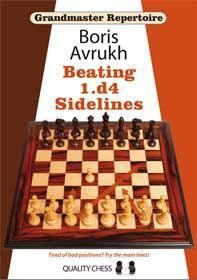Beating 1.d4 Sidelines
Grandmaster Repertoire 11
Boris Avrukh

The last fifteen years have seen a steady proliferation of opening repertoire books designed to meet secondary lines, many of which are not only respectable but dangerous for the unwary. These include some excellent books dealing with sidelines after 1.e4 e5 and 1.e4 c5 as well as works addressed to non-main lines after 1.d4 d5 and 1.d4 Nf6. Boris Avrukh has taken things to another level with his massive Beating 1.d4 Sidelines which offers not one repertoire but three.
Like his groundbreaking two volume works on 1.d4 and the Grunfeld, Avrukhs latest effort combines meticulous research, a large amount of analytical work, plus skill at breaking down the complicated into the understandable for the non-professional.
Beating 1.d4 Sidelines offers complete repertoires for those who meet 1.d4 with 1 d5, 1.d4 Nf6 2.Nf3 e6 and 1.d4 Nf6 2.Nf3 g6. Each one of these repertoires deals in depth with answers to systems like the Trompovsky, Torre Attack, Colle, Colle-Zukertort (the Colle with a queenside fianchetto), London System and the Barry (1.d4 Nf6 2.Nf3 g6 3.Nc3), which are the bread and butter of players from the club level to Grandmasters.
The table of contents gives but a hint of the content this book contains.
Part 1 1.d4 d5 lines
1. Rare 2nd Moves 9
2. Blackmar-Diemer Gambit 19
3. 2.Bg5 43
4. The Veresov 55
5. The London System 85
6. 2.Nf3 Nf6 Minor Lines 112
7. The Lame Torre 116
Part 2 1.d4 Nf6
8. 2.g3 (and others) 134
9. Trompowsky Intro and 3.h4 153
10. Trompowsky 3.Bh4 160
11. Trompowsky 3.Bf4 180
Part 3 1.d4 Nf6 2.Nf3 e6
12. Rare 3rd Moves 208
13. 3.g3 215
14. The Torre Attack 234
15. The London System 264
16. Colle 287
17. Colle-Zukertort (with c2-c4) 296
18. Colle-Zukertort (without c2-c4) 324
Part 4 1.d4 Nf6 2.Nf3 g6
19. Rare 3rd Moves 335
20. The Barry Attack 359
21. 3.e3 378
22. The London System 393
23. The Torre Attack 430
24. 3.g3 (without c2-c4) 467
For the Kings Indian/Grunfeld player Arukh offers the following lines.
His main line against the Torre is 1.d4 Nf6 2.Nf3 g6 3.Bg5 Bg7 4.Nbd2 0-0 5.c3 (5.e4 d5!) 5 d6 6.e4 c5 7.dxc5 dxc5 8.Bc4 Nc6 9.0-0 Qc7 a variation used with success by no less than Garry Kasparov twice. He defeated Artur Yusupov twice using this system when the later was one of the top players in the world and noted for being particularly hard to beat.
Avrukhs answer to the London is truly a reversed Reti opening 1.d4 Nf6 2.Nf3 g6 3.Bf4 Bg7 4.e3 0-0 5.Be2 d6 6.h3 c5 7.c3 b6 8.0-0 Bb7 9.Nbd2 Nbd7 10.a4 a6 11.Bh2 Ra7!?. The latter move is just how the great Reti use to interpret this opening when conducting the White pieces. Avrukh gives convincing evidence that it leads to a middlegame where all three results are in possible.
He offers a complete answer to the Barry, a one-time favorite of GMs Mark Hebden and Ian Rogers, showing that after 1.d4 Nf6 2.Nf3 g6 3.Nc3 d5 4.Bf4 Bg7 5.e3 0-0 6.Be2 c5 7.Ne5 Nc6 8.0-0 cxd4 9.cxd4 Bf5 10.Nxc6 bxc6 11.Na4 Nd7 Black has no troubles 12.c3 e5 13.Be3 Re8 14.Re1 Qc7 15.b4 Re7 16.Qd2 Rae8, =. All of Blacks pieces were well placed for the ensuing battle in Rogers-Dvoirys, Hoogoveen 2002.
Probably the single most important chapter in the book is Avrukhs proposed repertoire on how to handle the Trompovsky a line that has been played at the highest levels and which all those who answer 1.d4 with 1 Nf6 must be prepared to meet.
His solution is 1.d4 Nf6 2.Bg5 Ne4 3.Bf4 d5. When I saw this recommendation I was immediately curious to see how Avrukh proposed to answer the improved Blackmar-Diemer line 4.f3 Nf6 5.e4 as 5… dxe4 6.Nc3 dxe4 leads to a BDG a tempo down which has scored well for White. Avrukh concurs with this assessment. He thinks Gelfands 6…e3! is quite playable, but his main line is the almost untested 5 …c5!? to which he devotes almost seven pages.
Those who answer 1.d4 with 1 …d5 and 1.d4 Nf6 2.Nf3 e6 will not be disappointed with Avrukhs work. His coverage of the Colle and Colle-Zukertort overlaps at this point and is particularly comprehensive when dealing with the latter which has been the subject of several recent books. His main line 1.d4 Nf6 2.Nf3 e6 3.e3 d5 4.Bd3 c5 5.b3 Nc6 6.0-0 Bd6 7.Bb2 0-0 8.Nbd2 b6 9.Ne5 Bb7 10.f4 Rc8 11.a3 (as Nb4 was threatened) 11 …Ne7! preparing Ne4, often followed by f6, looks pretty convincing.
Avrukh not only deals with Whites main sidelines he also covers less known systems like the attempt to sideline sharp Catalan involving an early dxc4 with 1.d4 Nf6 2.Nf3 e6 3.g3. He counters this with 3 …d5 4.Bg2 b5! This solution highlights a characteristic of Avrukhs approach to opening problems he is a maximalist who avoids having a line do double duty if Black has better. For example He meets 1.d4 Nf6 2.g3 with 2… c5.
Beating 1.d4 Sidelines is the rare opening book that should find a wide audience as everyone (excepting those answering 1.d4 with 1 …g6, 1 …d6, 1 …Nc6 or 1… b5) will find this book useful.
Highly recommended for all players rated 1800 on up.
